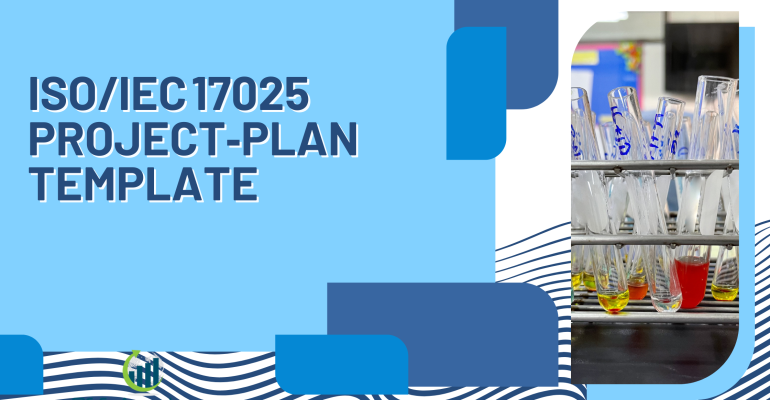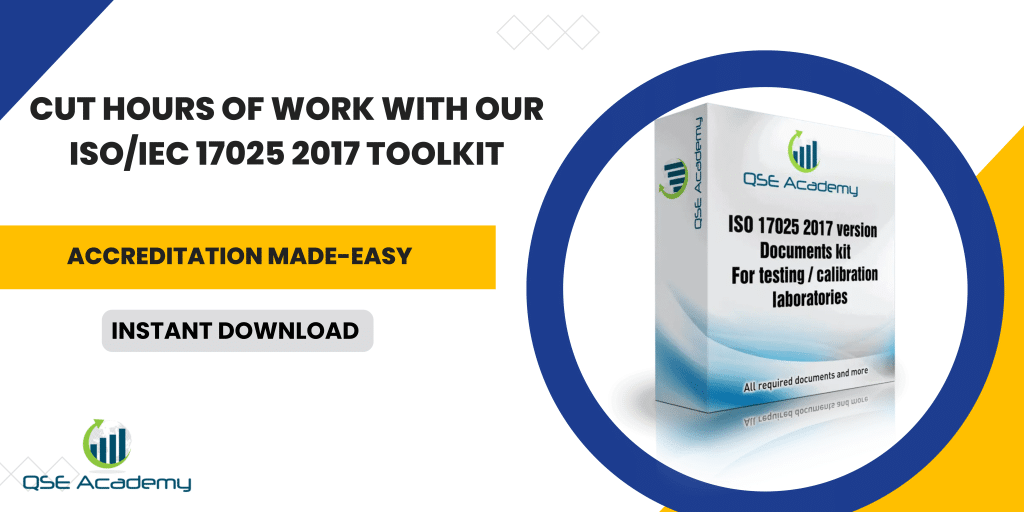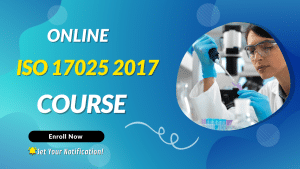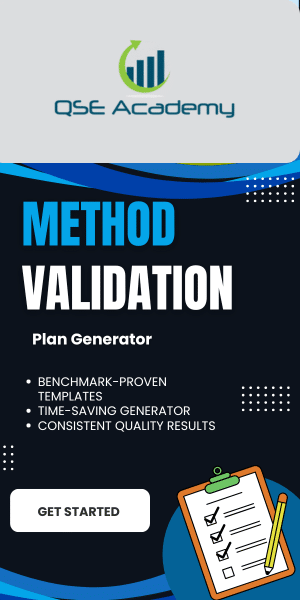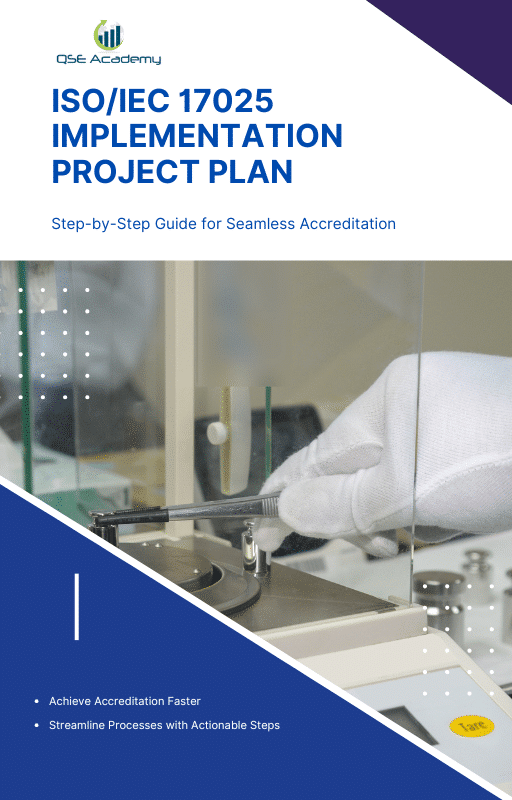ISO/IEC 17025 Project‑Plan Template
Last Updated on October 13, 2025 by Melissa Lazaro
Why Every Lab Needs a Clear ISO/IEC 17025 Project Plan
I’ve worked with enough laboratories to know that achieving ISO/IEC 17025 accreditation isn’t about the science—it’s about the structure. Most labs already have brilliant technical minds. What they often lack is a roadmap. I’ve seen teams burn months drafting documents, scheduling training, or trying to interpret clauses 6 through 8—only to realize they were working on the wrong priorities.
That’s exactly where a Project Plan Template changes the game.
In my experience helping testing and calibration labs prepare for accreditation, the ones that succeed fastest share one thing in common: they treat implementation like a project, not paperwork. They plan milestones, assign responsibilities, and track deliverables just like they would any R&D project.
Here’s what this guide will do for you:
-
Show you how to break ISO/IEC 17025 into clear, manageable phases.
-
Help you build accountability across your team.
-
Give you a ready-to-adapt structure that works whether you’re pursuing full accreditation or just closing compliance gaps.
By the end, you’ll walk away with a step-by-step framework—something you can actually plug into your daily workflow, not another theoretical checklist.
Understanding ISO/IEC 17025 Implementation Phases: Building the Foundation for Your Project Plan
When I first started guiding labs through ISO/IEC 17025, I noticed a common trend: teams dive straight into documentation. They start drafting procedures before truly understanding where they are in the bigger picture. That’s like trying to build a house without a blueprint.
The ISO/IEC 17025 journey follows a clear sequence—and once you see it as a project lifecycle, everything clicks into place.
The Six Core Phases of Implementation
Here’s a simple breakdown that I’ve seen work repeatedly across both testing and calibration labs:
-
Gap Analysis:
You start by comparing your current practices against the requirements of ISO/IEC 17025.-
What’s already compliant?
-
What needs improvement?
-
Which processes don’t exist yet?
Pro Tip: Don’t rush this part. A good gap analysis sets the tone for your entire project.
-
-
Documentation Development:
Once gaps are clear, you begin developing your quality manual, SOPs, and supporting forms.-
Think of this as the “design phase” of your quality system.
-
Avoid copy-pasting templates; adapt them to reflect your lab’s real workflow.
Pitfall: Using generic procedures that your staff can’t relate to—this leads to audit findings later.
-
-
Implementation & Training:
This is where the system comes alive. Train your team, apply the procedures, and start keeping real records.-
Encourage open feedback—sometimes the best process improvements come from technicians.
-
-
Internal Audit:
Before any external assessor walks in, you need to test your system.-
Internal audits reveal weak spots early.
-
Assign competent auditors who can look beyond checklists and assess process performance.
-
-
Management Review:
Leadership evaluates audit results, customer feedback, and improvement opportunities.-
This phase ensures accountability and drives continual improvement.
Pro Tip: Don’t treat it as a formality—management reviews are your quality steering wheel.
-
-
Pre-Assessment & Accreditation Audit:
The final stage. You confirm readiness and apply to your chosen accreditation body (SANAS, A2LA, UKAS, etc.).-
Use a pre-assessment to simulate the real audit and fix issues beforehand.
-
Why This Sequence Matters
I’ve seen labs try to skip steps—jumping straight from documentation to audit submission—and then scrambling when auditors ask for evidence of implementation or management review records. Following these phases in order not only saves time, it builds confidence and structure.
When you view your ISO/IEC 17025 implementation as a project with phases, it stops feeling like endless paperwork and starts feeling like a clear, achievable plan.
Setting Project Objectives and Scope: Defining What Success Looks Like
One thing I’ve learned working with labs is this: if you don’t clearly define your objectives at the start, your ISO/IEC 17025 project will drift. Teams end up arguing over priorities, deadlines slip, and everyone feels like they’re “busy” but not really moving forward.
That’s why your project plan needs a well-defined scope and objectives right up front.
Clarifying Your Project Objectives
Ask yourself: Why are we pursuing ISO/IEC 17025 right now?
From my experience, labs usually fall into one of three categories:
-
Full Accreditation: New labs or those expanding into new markets who need formal accreditation.
-
Scope Extension: Labs already accredited but adding new tests or calibration parameters.
-
Compliance Readiness: Labs that aren’t going for full accreditation yet but want to align with ISO 17025 principles.
Each objective shapes your project differently. For example:
-
A calibration lab aiming for five accredited parameters in six months has a very different workload than a test lab adding a single new scope element.
How to Define Scope Effectively
Scope is about what’s in and what’s out of your project. Without this, I’ve seen labs try to “boil the ocean” by addressing every single clause at once—which is a recipe for burnout.
Here’s how I guide clients through it:
-
Identify laboratory activities covered: Which tests or calibrations fall under accreditation?
-
Decide on exclusions: Which areas aren’t relevant or feasible right now?
-
Set boundaries: Are you including just one department, or the whole lab?
Pro Tip: Use a “Scope Statement” in your project plan. One or two clear sentences that your entire team can rally around.
Example:
“This project will implement ISO/IEC 17025 for the calibration of pressure gauges and thermometers, with the objective of achieving SANAS accreditation within six months.”
Common Pitfalls to Avoid
-
Too broad a scope: Trying to accredit every method at once. Better to start focused, succeed, and expand later.
-
Unclear objectives: “We just want accreditation” isn’t enough. You need timelines, methods, and parameters defined.
-
Lack of alignment: Leadership wants accreditation in 6 months, but technical staff believe it’ll take 12. That gap will cause friction unless resolved early.
Why This Matters
Defining objectives and scope isn’t paperwork—it’s your compass. Without it, you’ll constantly question priorities. With it, every task in your project plan ties back to the bigger picture.
Team Roles and Responsibilities: Building the Right ISO/IEC 17025 Project Team
Every successful ISO/IEC 17025 implementation I’ve seen had one thing in common: a strong, clearly defined team.
You can have the best templates and timelines in the world, but if people don’t know who’s doing what—the project stalls.
Start by Defining Key Roles
Here’s how I usually help labs structure their ISO/IEC 17025 project teams. The exact titles can vary, but the functions remain essential:
-
Project Leader / Quality Manager
-
Oversees the entire project and ensures compliance with the standard.
-
Coordinates between management, technical staff, and consultants.
-
Keeps everyone accountable for deadlines and deliverables.
Pro Tip: Choose someone with influence, not just experience. ISO 17025 projects need authority to cut through red tape.
-
-
Technical Manager
-
Ensures technical validity of methods, calibrations, and testing processes.
-
Approves technical procedures and supervises training of technical staff.
-
Acts as the bridge between daily lab operations and quality requirements.
-
-
Document Controller
-
Manages all quality documents, procedures, and forms.
-
Tracks version control and ensures obsolete documents are removed.
-
Pitfall: I’ve seen labs underestimate this role—then drown in conflicting procedures. Assign a dedicated person early.
-
-
Process Owners / Section Heads
-
Implement procedures in their departments.
-
Ensure daily work aligns with documented processes.
-
Provide feedback on practicality during the implementation phase.
-
-
Top Management
-
Provides resources, removes barriers, and reinforces the importance of the project.
-
Participates actively in management reviews, not just as signatories.
-
How to Make It Work in Practice
I once worked with a mid-sized calibration lab where everyone wore multiple hats. The lab manager was also the quality lead and part-time auditor. Predictably, things fell through the cracks—documents were overdue, and internal audits kept being postponed.
Once we restructured responsibilities into a clear project team, progress accelerated.
Here’s what worked:
-
Weekly check-ins with short status updates.
-
RACI Matrix (Responsible, Accountable, Consulted, Informed) to define who owns what.
-
Shared project tracker (Excel or software) to visualize progress.
Common Mistakes to Avoid
-
Assigning roles based on seniority instead of competence.
-
Failing to allocate time—if staff already have full workloads, your project will always take a back seat.
-
Neglecting communication. ISO 17025 implementation isn’t just about documentation—it’s about alignment.
Pro Tip
Create a one-page “Roles and Responsibility Summary” as part of your project plan.
Make it visible to everyone. When accountability is clear, your implementation moves faster—and smoother.
Timeline and Milestones: Turning Your ISO/IEC 17025 Plan Into Action
Here’s what I’ve noticed over the years: labs don’t fail ISO 17025 projects because they don’t care—they fail because they lose track of time.
Without a timeline, your team will always feel “busy,” but months later, you’ll realize documentation is half-done, internal audits haven’t started, and your accreditation deadline is looming.
A clear project schedule changes that completely. It brings structure, accountability, and motivation.
Breaking Down the ISO/IEC 17025 Timeline
Every project will look a little different, but here’s a realistic structure I use with most labs:
| Phase | Duration | Key Deliverables |
|---|---|---|
| Month 1 – Gap Analysis | 2–4 weeks | Gap report, action list, project scope confirmation |
| Month 2–3 – Documentation Development | 6–8 weeks | Quality Manual, SOPs, templates, calibration & testing records |
| Month 4 – Implementation & Training | 4 weeks | Staff trained, procedures in use, records generated |
| Month 5 – Internal Audit & Management Review | 4 weeks | Completed internal audit, management review minutes, corrective actions |
| Month 6 – Pre-assessment & Accreditation Submission | 4 weeks | Mock audit, readiness checklist, application to accreditation body |
This structure keeps your project on track while giving enough breathing room to solve real-world issues.
How to Track Milestones Effectively
I like to treat milestones as “gates”—you can’t move to the next phase until the current one is complete.
For instance:
-
Don’t begin training until documentation is approved.
-
Don’t schedule a pre-assessment until internal audits and management reviews are closed.
Pro Tip: Use a simple Gantt chart—Excel, Trello, or project-management software works fine. What matters isn’t the tool; it’s the discipline to update it weekly.
Example: A Calibration Lab’s 6-Month Journey
One of my clients, a small calibration lab, set out to achieve SANAS accreditation in six months. They followed this exact structure.
By assigning every milestone a “champion” and holding 20-minute weekly check-ins, they finished documentation by Week 10, completed their internal audit by Week 18, and were audit-ready by Week 24.
That kind of momentum only happens when timelines are visible and realistic.
Common Pitfalls
-
Over-ambitious deadlines: I’ve seen labs try to do it in two months. They burn out before the audit.
-
No buffer time: Build at least a 10–15 % margin for unexpected issues (equipment downtime, staff turnover, etc.).
-
Ignoring progress tracking: “We’ll catch up later” rarely happens.
Final Thought
Your ISO 17025 timeline is more than a schedule—it’s your accountability framework.
When everyone knows what’s due, by whom, and when, the standard stops feeling like bureaucracy and starts becoming a system that actually supports your lab’s success.
Documentation Development Plan: Creating a Quality System That Actually Works
Here’s something I tell every client right away — your documentation can either empower your team or overwhelm them.
ISO/IEC 17025 isn’t about writing piles of procedures; it’s about creating a system that reflects how your lab truly works.
When documentation feels natural and usable, staff follow it. When it feels forced or copied, it gets ignored — and that’s where nonconformities start showing up.
Mapping Out the Required Documentation
At its core, your documentation system should include four key levels:
-
Quality Manual:
-
Think of this as your lab’s “constitution.” It outlines your quality policy, structure, and how you meet each clause of ISO/IEC 17025.
-
Keep it concise — 20–30 pages is plenty for most labs.
-
-
Procedures / SOPs:
-
These describe how activities are performed — from equipment calibration to sample handling.
-
Avoid generic language; use terms your technicians actually use daily.
-
-
Work Instructions:
-
Step-by-step guides for specific tasks or instruments.
-
Often include photos, equipment IDs, or tolerance limits.
-
-
Records and Forms:
-
Evidence that procedures are followed — calibration sheets, training logs, test reports, etc.
-
Pro Tip: Build forms digitally to reduce errors and missing fields.
-
Building a Document Matrix
A practical way to stay organized is by creating a Document Matrix — a simple spreadsheet listing all required documents, their owners, revision numbers, and status (draft, review, approved).
Example:
| Document Title | Owner | Status | Last Revision |
|---|---|---|---|
| Quality Manual | Quality Manager | Approved | 01-Aug-2025 |
| Calibration SOP – Pressure Gauges | Technical Manager | In Review | 22-Jul-2025 |
| Internal Audit Procedure | Quality Manager | Approved | 15-Jun-2025 |
Pro Tip: This table also becomes your best audit tool — assessors love it when documentation is traceable and controlled.
Keep It Simple and Real
One calibration lab I helped had over 200 uncontrolled Word files floating around before we started.
We consolidated everything into 35 controlled documents with clear version tracking. The result? Staff compliance improved, audit prep time dropped by 50%, and updates became painless.
That’s the goal — fewer, better documents that reflect real practice.
Common Mistakes to Avoid
-
Copy-paste syndrome: Borrowing templates without adapting them to your processes. Accreditation bodies can spot that instantly.
-
Too much detail: You don’t need to describe how to turn on a computer — focus on what affects quality.
-
Ignoring document control: Outdated procedures circulating on lab benches lead to chaos during audits.
Final Tip
Keep documentation alive. Review it during management reviews, update it after audits, and make it part of your lab culture — not just a binder on a shelf.
Monitoring, Review, and Continuous Improvement: Keeping Your ISO/IEC 17025 System Alive
Here’s something I’ve seen time and again: labs put in months of effort to get accredited, pass the audit — and then the system slowly fades into “maintenance mode.” Documents stop getting updated, internal audits get delayed, and management reviews become rushed formality meetings.
That’s the fastest way to lose momentum — and eventually, your accreditation.
The truth is, ISO/IEC 17025 isn’t a one-time project. It’s a living system. Continuous improvement is what keeps it relevant and effective.
Step 1: Measure What Matters
You can’t improve what you don’t measure.
Set up Key Performance Indicators (KPIs) that help you see if your system is actually working.
Here are metrics I usually recommend to clients:
| Area | KPI Example | Target |
|---|---|---|
| Documentation | % of documents reviewed on schedule | 100% |
| Internal Audits | % of findings closed within target date | 95% |
| Training | % of staff competency evaluations completed | 100% |
| Customer Feedback | % of positive responses | 90% |
| Nonconformities | Average closure time | <30 days |
Pro Tip: Track KPIs monthly or quarterly. Display them visually — charts or dashboards work better than long reports.
Step 2: Conduct Regular Internal Audits
Internal audits aren’t just about compliance — they’re your early warning system.
They help you spot inefficiencies, unclear procedures, or training needs before an external auditor does.
I tell every team I work with: treat internal audits as improvement opportunities, not policing exercises.
Encourage your auditors to ask “why” and “how can this be better?” instead of just ticking boxes.
Step 3: Use Management Reviews to Drive Change
Too often, management reviews become paperwork — a checklist item done once a year.
But when done right, they’re one of your most powerful improvement tools.
Use the review to:
-
Evaluate audit results and corrective actions.
-
Assess resource needs (equipment, staff, training).
-
Review risks, opportunities, and customer feedback.
-
Approve improvement actions and assign owners.
Pro Tip: Keep your management review minutes short and focused — one page per topic is plenty. What matters is the follow-up action.
Step 4: Close the Loop
Once corrective actions are implemented, verify their effectiveness.
If an internal audit found calibration logs incomplete, don’t just fix the form — check two months later if the change stuck.
This is where continuous improvement really happens:
-
Plan → Do → Check → Act (the PDCA cycle).
-
Document lessons learned after each issue and share them during team meetings.
Common Pitfalls
-
Treating improvement as optional: ISO 17025 expects you to demonstrate continual improvement — not just react to problems.
-
Tracking too many metrics: Focus on a handful of meaningful KPIs.
-
Neglecting verification: Fixing problems without checking results leads to repeat findings.
Real Example
A testing lab I consulted with reduced audit findings by 70% in one year just by introducing a “Monthly Quality Health Check” — a 30-minute review of KPIs, audit findings, and improvement actions.
It became part of their culture, not a chore.
That’s what continual improvement looks like — simple, consistent, and built into your routine.
Final Readiness & Pre-Assessment: Getting Your Lab Audit-Ready with Confidence
When your ISO/IEC 17025 system finally starts running smoothly, it’s tempting to think, “We’re ready — let’s call the accreditor.”
But in my experience, that last stretch — the readiness and pre-assessment stage — is where the best labs separate themselves from the rest.
It’s not about scrambling to look perfect. It’s about proving that your system works consistently, day after day.
Step 1: Do a Self-Evaluation Before Anyone Else Does
A solid self-assessment is your best rehearsal for the real thing.
I usually guide teams to review every clause of ISO/IEC 17025 using a checklist that mirrors their accreditation body’s audit format.
Focus on three areas:
-
Evidence: Can you show records for every process (training, calibration, traceability)?
-
Effectiveness: Are those processes actually being followed?
-
Consistency: Are results reproducible across staff, shifts, and equipment?
Pro Tip: Have someone outside your project team — maybe another department or external consultant — perform the internal review. Fresh eyes catch things you might overlook.
Step 2: Conduct a Mock or Pre-Assessment Audit
Treat it like the real thing. Schedule it, announce it, and give your team the same level of seriousness.
During a mock audit:
-
Review your quality manual, procedures, and calibration/test records.
-
Interview staff to ensure they understand their roles.
-
Check if corrective actions from previous audits are closed.
What I’ve noticed: when labs take mock audits seriously, the final accreditation audit often feels like a confirmation rather than an interrogation.
Pro Tip: Record findings from the mock audit and address them just like official nonconformities — with root cause, correction, and verification.
Step 3: Finalize Your Readiness Documentation
Before applying for accreditation, confirm that these documents are finalized and controlled:
-
Quality Manual (latest revision)
-
All procedures and forms used in daily operation
-
Internal audit reports and management review minutes
-
Competence and training records
-
Equipment calibration certificates and traceability evidence
-
Corrective action reports and improvement logs
This list might look long, but having it in order builds massive confidence during the real audit.
Step 4: Submit and Prepare for the Accreditation Audit
Once you’re confident, submit your application to the accreditation body (SANAS, UKAS, A2LA, etc.).
Expect them to review your documents first (desktop review) before visiting your lab.
Here’s what helps your team feel prepared:
-
Hold a briefing session: Walk through the audit plan, explain who will answer which questions.
-
Organize evidence folders: Physically or digitally. Label everything by clause for easy reference.
-
Stay calm: Assessors aren’t there to trap you — they just want to see that your system works in real life.
Common Mistakes in the Final Stage
-
Rushing documentation updates right before the audit — assessors notice last-minute revisions.
-
Under-preparing staff: Frontline technicians should be confident explaining their procedures.
-
Ignoring the closing meeting: Always discuss findings, clarify misunderstandings, and request examples for any nonconformities.
Real-World Example
A testing lab I worked with failed their first accreditation audit due to inconsistent traceability records.
They regrouped, built a one-page calibration-traceability tracker, and ran a second pre-assessment two months later.
When the real audit came, they passed with zero majors.
Their secret wasn’t perfection — it was preparation.
Takeaway
The readiness stage isn’t just a final check; it’s your chance to prove reliability — the very essence of ISO/IEC 17025.
Do the work here, and you’ll walk into your accreditation audit with confidence, not anxiety.
FAQs: Your Common ISO/IEC 17025 Project Planning Questions, Answered
After helping dozens of labs roll out ISO/IEC 17025 systems, I’ve noticed that the same few questions always come up — right around the point when teams start finalizing their project plan.
Let’s clear those up right here.
Q1: How long does it actually take to implement ISO/IEC 17025?
In most cases, small to mid-sized labs can complete the process in 4 to 6 months if they stay consistent.
That includes gap analysis, documentation, training, internal audit, and pre-assessment.
If you’re juggling multiple scopes or running several departments, expect closer to 8–12 months.
Pro Tip: Set “soft” internal deadlines one to two weeks ahead of your real targets. It builds a buffer and keeps your momentum.
Q2: Can we use a project-plan template for both testing and calibration labs?
Absolutely. The framework stays the same — only the technical details and scope differ.
A testing lab might focus more on sample handling, uncertainty, and environmental conditions, while a calibration lab focuses on equipment traceability and measurement assurance.
The template simply provides the structure; you’ll adjust the content to fit your operation.
Q3: Do we really need a consultant to implement ISO/IEC 17025?
Not always — but it can save you a lot of trial and error.
If your team is confident interpreting the clauses, go for it independently.
If not, a consultant can shorten your learning curve, help you build documentation correctly the first time, and guide your team through the audit expectations.
In my experience, labs that get professional guidance from day one tend to achieve accreditation 30–40% faster — simply because they avoid backtracking on misunderstood requirements.
Q4: What’s the biggest mistake labs make during ISO 17025 implementation?
Easy: treating it like a paperwork exercise.
ISO/IEC 17025 is about competence, not binders.
If your documents look great but your team doesn’t follow them in daily operations, you’ll face nonconformities.
Focus on culture before checklists. Once people understand the “why,” the “what” becomes easy.
Turning Your ISO/IEC 17025 Project Plan Into a Real Accreditation Win
If there’s one thing I’ve learned after years of helping laboratories get accredited, it’s this — ISO/IEC 17025 success isn’t about luck; it’s about structure.
Labs that plan the journey like a project, with timelines, accountability, and clear milestones, always get there faster and with fewer audit surprises.
Key Takeaways
Let’s recap what we’ve covered:
-
Your project needs direction. Define your objectives and scope early so everyone’s working toward the same goal.
-
People make the difference. Assign clear roles — Quality Manager, Technical Manager, Document Controller — and empower them.
-
Structure saves time. A well-built timeline and document plan keep implementation from becoming chaos.
-
Improvement never stops. Monitoring, audits, and management reviews turn your system into a living, improving framework.
-
Preparation builds confidence. A strong pre-assessment and readiness review set the tone for a smooth accreditation audit.
These aren’t theories — they’re what I’ve seen work over and over again across labs of all sizes and sectors.
A Quick Word on Trust and Experience
I’ve guided calibration and testing laboratories through SANAS, A2LA, and UKAS accreditations — some from the ground up, others recovering from failed audits.
In every case, the turning point wasn’t new equipment or more staff.
It was a solid, easy-to-follow ISO/IEC 17025 project plan that brought order to the process.
That’s exactly why QSE Academy developed the Complete ISO/IEC 17025 Project-Plan Template — designed by practitioners, not theorists, to help labs move from confusion to certification.
Your Next Step
If you’re serious about getting your lab accredited efficiently and confidently:
Download the Complete ISO/IEC 17025 Project-Plan Template — a ready-to-use roadmap with milestones, roles, and documentation tools.
Or work with our ISO/IEC 17025 consultants who can tailor the plan to your specific laboratory, saving you months of trial and error.
You’ve already done the hardest part — getting started.
Now, with the right project plan in hand, you can move forward with clarity, confidence, and structure — and finally earn the accreditation your lab deserves.
I hold a Master’s degree in Quality Management, and I’ve built my career specializing in the ISO/IEC 17000 series standards, including ISO/IEC 17025, ISO 15189, ISO/IEC 17020, and ISO/IEC 17065. My background includes hands-on experience in accreditation preparation, documentation development, and internal auditing for laboratories and certification bodies. I’ve worked closely with teams in testing, calibration, inspection, and medical laboratories, helping them achieve and maintain compliance with international accreditation requirements. I’ve also received professional training in internal audits for ISO/IEC 17025 and ISO 15189, with practical involvement in managing nonconformities, improving quality systems, and aligning operations with standard requirements. At QSE Academy, I contribute technical content that turns complex accreditation standards into practical, step-by-step guidance for labs and assessors around the world. I’m passionate about supporting quality-driven organizations and making the path to accreditation clear, structured, and achievable.

